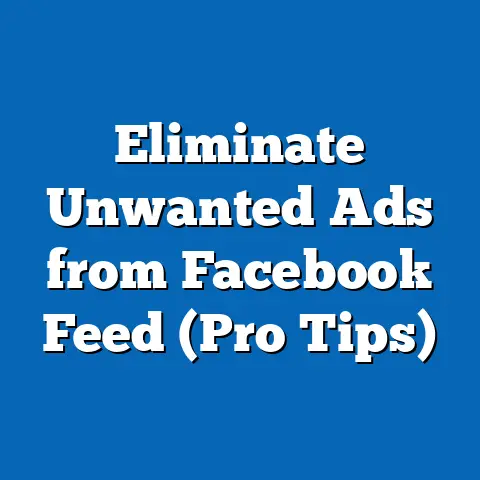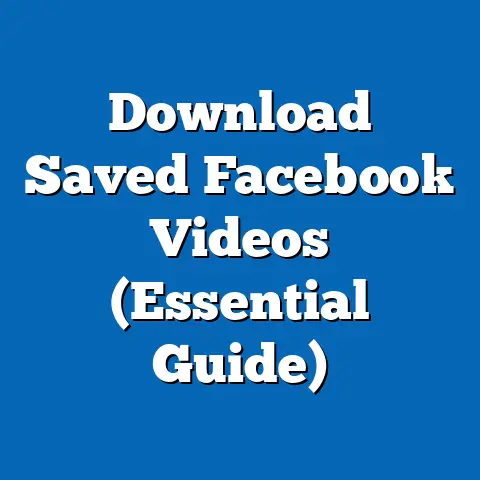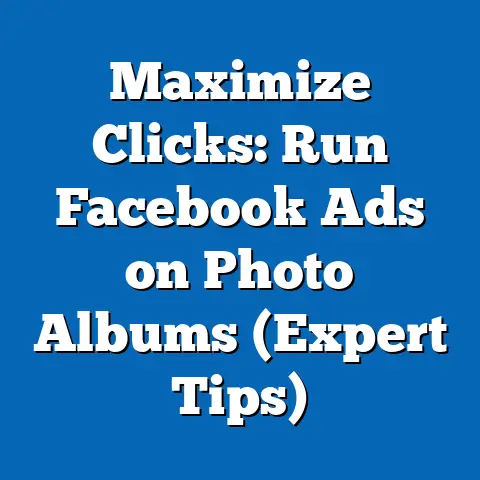How Facebook Made Money Before Ads (Revenue Secrets Unveiled)
The business world is constantly evolving, and the companies that thrive are those that understand the art of layering. Layering, in a business context, is the strategic addition of revenue streams over time, allowing a company to build a solid foundation before fully relying on a single source of income. Think of it as building a skyscraper: you don’t start with the penthouse; you lay the groundwork, the foundation, and then gradually add floors, each strengthening the structure. In the digital realm, this concept is especially crucial. Companies need to be agile, experimenting with different monetization methods before settling on what works best.
Facebook, the behemoth of social media advertising, wasn’t always swimming in ad revenue. In its early days, before it became synonymous with targeted ads and marketing campaigns, Facebook had to be resourceful. They had to find innovative ways to keep the lights on and fuel their growth. As someone deeply entrenched in the world of digital marketing, I’ve always been fascinated by the “before the ad” era of Facebook. It’s a story of ingenuity, strategic partnerships, and a deep understanding of user behavior. This article will dive into those revenue secrets, unveiling how Facebook thrived before the reign of advertising.
Section 1: The Early Days of Facebook
Overview of Facebook’s Launch
It all began in a Harvard dorm room in 2004. Mark Zuckerberg, along with his fellow students, launched “The Facebook,” a platform designed to connect students. The initial vision was simple: create a digital space where people could easily find and connect with others on campus. This exclusivity, focusing solely on college students, was a key factor in its early success. It created a sense of community and belonging.
I remember when Facebook first started gaining traction. I was in college myself, and it quickly became the way to connect with friends, find out about parties, and even check out what classes people were taking. It was a much more streamlined and social experience than anything we had before.
But a cool platform alone doesn’t pay the bills. Facebook faced the daunting challenge of sustaining operations without a clear revenue model. Servers, development, and bandwidth all cost money. The initial funding from investors like Peter Thiel certainly helped, but it wasn’t a long-term solution. The pressure was on to find a way to monetize the platform.
Revenue Models Explored
In those early days, Facebook explored several alternative revenue models, none of which involved the targeted advertising we know today. These strategies were more about experimentation and figuring out what resonated with users.
- Premium Features (Rumored): There were whispers of potential premium features, like enhanced profile customization or the ability to send virtual gifts. However, these never really materialized in a significant way.
- Job Board: One of the earliest attempts at monetization was a job board feature where companies could post job openings specifically targeting college students. This was a natural fit for the platform, given its user base.
- Partnerships: Facebook also explored partnerships with other companies, offering integration with services like music platforms. These partnerships often involved revenue-sharing agreements.
The significance of user engagement can’t be overstated. Facebook understood that the more users spent time on the platform, the more valuable it became. High user retention was the name of the game. They focused on creating a compelling experience that kept people coming back for more. This would later become the foundation for their advertising success.
Takeaway: Facebook’s early days were about experimentation and prioritizing user engagement. They explored various revenue models, but the key was to build a platform that people loved and wanted to use.
Section 2: Subscription and Premium Features
Exploration of Subscription Models
The idea of subscription models was definitely on the table in Facebook’s early days. The question was: what features would users be willing to pay for?
- Enhanced Profile Customization: One idea floated around was offering users the ability to further customize their profiles with unique designs or layouts for a small monthly fee.
- Increased Privacy Controls: Another concept involved offering enhanced privacy settings that went beyond the basic options, giving users more control over who could see their information.
However, these attempts at introducing subscription services met with mixed reactions. Users were generally hesitant to pay for features that they felt should be included for free. There was a strong perception that Facebook should remain a free platform.
The challenges encountered in monetizing subscriptions were significant:
- User Resistance: As mentioned, users were resistant to paying for features that seemed like basic functionalities.
- Competition: Other social platforms were offering similar features for free, making it difficult for Facebook to justify charging for them.
- Value Proposition: It was challenging to create a compelling value proposition that would convince a significant number of users to subscribe.
Premium Features and Their Impact
While a full-fledged subscription model didn’t take off, Facebook did experiment with some premium features designed to enhance the user experience.
- Virtual Gifts: One example was the introduction of virtual gifts, which users could send to their friends for a small fee. These gifts were essentially digital stickers that appeared on a user’s profile.
- Enhanced Event Promotion: Facebook also explored ways for event organizers to promote their events more effectively for a fee, reaching a wider audience.
The financial impact of these features was relatively modest compared to what Facebook would later achieve with advertising. However, these experiments were valuable in several ways:
- Understanding User Willingness to Pay: They provided insights into what types of features users were willing to pay for, even if it was just a small amount.
- Testing Monetization Strategies: They allowed Facebook to test different monetization strategies without alienating its user base.
- Data Collection: They provided valuable data on user behavior and preferences, which would later be used to refine their advertising model.
I remember sending virtual gifts to my friends on Facebook back then. It was a fun, quirky way to show appreciation. While it wasn’t a major revenue driver for Facebook, it did contribute to the overall user experience and fostered a sense of community.
Takeaway: While subscription and premium features didn’t become a primary revenue source, they provided valuable lessons and insights into user behavior and willingness to pay. These experiments helped shape Facebook’s future monetization strategies.
Section 3: Strategic Partnerships and Collaborations
Early Partnerships
Even before the era of hyper-targeted ads, Facebook recognized the power of partnerships. These collaborations allowed them to expand their reach, diversify their offerings, and, crucially, generate revenue.
- Music Services: Integrating with music platforms like Spotify was a natural fit. Users could share what they were listening to, creating a social music experience. Facebook likely received a cut of any subscriptions or purchases made through these integrations.
- Gaming Platforms: Facebook also partnered with gaming companies, allowing users to play games directly on the platform. This generated revenue through in-game purchases and virtual item sales.
- Other Tech Companies: They also explored partnerships with other tech companies, offering integrations with their services. This could involve revenue-sharing agreements or cross-promotion deals.
These collaborations were crucial for several reasons:
- Diversified Offerings: They allowed Facebook to offer a wider range of services to its users, making the platform more appealing.
- Increased User Engagement: They encouraged users to spend more time on Facebook, as they could access various services without leaving the platform.
- Indirect Revenue Generation: While not directly advertising, these partnerships often involved revenue-sharing agreements, contributing to Facebook’s bottom line.
Brand Collaborations
Even before the formal ad platform, brands were eager to tap into Facebook’s massive user base. They found creative ways to utilize the platform for promotions and campaigns.
- Sponsored Groups: Brands could create and sponsor groups related to their products or services, engaging with potential customers in a more organic way.
- Contests and Giveaways: Brands could run contests and giveaways on Facebook, generating buzz and attracting new followers.
- Early Influencer Marketing: While not as sophisticated as today’s influencer marketing, brands would often collaborate with popular users to promote their products.
These early brand collaborations were significant because:
- Proof of Concept: They demonstrated the potential of Facebook as a marketing platform, paving the way for the formal ad system.
- Brand Awareness: They allowed brands to reach a large audience and build brand awareness.
- Direct Engagement: They facilitated direct engagement between brands and their customers.
One example that stands out is a campaign I remember seeing for a new energy drink. They created a Facebook group where users could share their experiences with the drink and participate in contests. It was a clever way to build a community around the product and generate buzz.
Takeaway: Strategic partnerships and brand collaborations were essential for Facebook’s early revenue generation. They allowed the platform to diversify its offerings, increase user engagement, and demonstrate its value to brands.
Section 4: Data Monetization Before Ads
Understanding Data as a Commodity
Even before the sophisticated targeting options of today, Facebook understood the immense value of the data it was collecting. User data, even in its raw form, was a valuable commodity.
They understood that information about user demographics, interests, and connections could be used to create value for businesses. This was long before the ethical debates surrounding data privacy became mainstream.
The ethical implications of data monetization during this phase are worth noting. While Facebook wasn’t selling user data directly to advertisers, they were using it to create services and products that benefited businesses. This raised questions about transparency and user consent.
Selling Analytics and Insights
Before the launch of its ad platform, Facebook explored ways to sell analytics and insights based on user data.
- Aggregated Demographic Data: They could provide businesses with aggregated demographic data about their target audience, such as age, gender, location, and interests.
- Trend Analysis: They could analyze trends in user behavior and provide insights into what was popular and trending on the platform.
- Social Network Analysis: They could map out social networks and identify key influencers within specific communities.
These services were valuable to businesses because:
- Improved Targeting: They helped businesses better understand their target audience and tailor their marketing efforts accordingly.
- Informed Decision-Making: They provided insights that could inform business decisions, such as product development and marketing strategy.
- Competitive Advantage: They gave businesses a competitive advantage by allowing them to stay ahead of the curve and anticipate trends.
This strategy laid the groundwork for the later success of Facebook’s advertising model. By demonstrating the value of data-driven insights, Facebook paved the way for advertisers to embrace targeted advertising.
I remember hearing about companies paying a premium for access to Facebook’s data insights back then. It was clear that the platform was sitting on a goldmine of information.
Takeaway: Data monetization, even before the ad platform, was a key revenue strategy for Facebook. They understood the value of user data and found ways to sell analytics and insights to businesses. This set the stage for their future success in advertising.
Section 5: The Role of User Engagement and Community Building
Community-Centric Approach
From the very beginning, Facebook prioritized building communities and engaging users. They understood that a vibrant and active community was essential for the platform’s success.
This community-centric approach wasn’t just about making users happy; it was also a revenue strategy. The more engaged users were, the more valuable the platform became to businesses.
User-generated content and interactions provided inherent value that could be monetized indirectly. This content attracted more users, increased engagement, and created opportunities for businesses to connect with their target audience.
Impact of Engagement on Revenue Generation
Facebook tracked various metrics to quantify user engagement and its correlation to potential revenue avenues.
- Daily Active Users (DAU): This metric measured the number of users who logged into Facebook each day.
- Monthly Active Users (MAU): This metric measured the number of users who logged into Facebook each month.
- Time Spent on Platform: This metric measured the average amount of time users spent on Facebook each day.
- Content Creation: This metric measured the amount of content users were creating, such as posts, photos, and videos.
- Interaction Rate: This metric measured the level of interaction on the platform, such as likes, comments, and shares.
These metrics were crucial for several reasons:
- Attracting Investors: They demonstrated the platform’s growth and potential to investors.
- Attracting Businesses: They showed businesses the value of advertising on Facebook.
- Informing Product Development: They provided insights into what features and content were most engaging to users.
Fostering a vibrant community contributed to Facebook’s early sustainability by:
- Increasing User Retention: Engaged users were more likely to stay on the platform, reducing churn.
- Attracting New Users: A vibrant community attracted new users, further fueling growth.
- Creating a Network Effect: The more users joined the platform, the more valuable it became to everyone.
I remember spending hours on Facebook back then, connecting with friends, joining groups, and sharing content. It was a truly engaging experience, and it’s no surprise that the platform grew so rapidly.
Takeaway: User engagement and community building were essential for Facebook’s early success. By prioritizing these aspects, Facebook created a platform that users loved and wanted to use, which ultimately paved the way for its future monetization strategies.
Section 6: Transitioning to Advertising
The Shift Towards Ads
The transition from early revenue models to advertising was a gradual process that involved several key turning points.
Previous revenue strategies informed this transition by:
- Providing Data on User Behavior: The data collected from early revenue models helped Facebook understand what types of advertising would be most effective.
- Building Relationships with Businesses: The partnerships and brand collaborations established before the ad platform created a foundation for future advertising relationships.
- Demonstrating the Value of Data-Driven Insights: The success of selling analytics and insights paved the way for advertisers to embrace targeted advertising.
Lessons Learned from Early Revenue Models
The insights gained from earlier revenue strategies shaped Facebook’s advertising approach in several ways.
- Prioritize User Experience: Facebook learned that it was crucial to prioritize user experience when introducing advertising. Ads needed to be relevant and non-intrusive.
- Focus on Targeting: The data collected from early revenue models highlighted the importance of targeted advertising. Ads that were relevant to users were more likely to be effective.
- Build a Strong Relationship with Advertisers: Facebook understood that it needed to build a strong relationship with advertisers to ensure the long-term success of its advertising platform.
The company’s understanding of user behavior and data utilization set the stage for its advertising success. By leveraging its vast trove of user data, Facebook was able to create a highly effective advertising platform that delivered impressive results for businesses.
Takeaway: The transition to advertising was a gradual process that was informed by Facebook’s early revenue strategies. The insights gained from these early experiments helped shape Facebook’s advertising approach and set the stage for its future success.
Conclusion: The Legacy of Diverse Revenue Strategies
In conclusion, Facebook’s journey to becoming an advertising giant was paved with diverse and innovative revenue strategies. Before the reign of targeted ads, the company experimented with premium features, strategic partnerships, data monetization, and a strong focus on community building.
These early strategies were critical in allowing Facebook to survive and grow before the advent of its robust ad platform. They provided valuable insights into user behavior, built relationships with businesses, and demonstrated the potential of data-driven insights.
The importance of diversification and innovation in revenue generation cannot be overstated. In today’s rapidly evolving digital landscape, companies need to be agile and adaptable, constantly exploring new ways to monetize their platforms.
Looking ahead, the future of revenue models in social media is likely to be even more diverse and innovative. Platforms like Facebook will continue to experiment with new ways to generate revenue, adapting to changing user behavior and emerging technologies.
The story of Facebook’s early revenue strategies serves as a reminder that success in the digital world requires creativity, adaptability, and a deep understanding of user needs. It’s a story of how a company can build a solid foundation by layering different revenue streams, ultimately paving the way for long-term success.
Final Thought: What new and innovative revenue models will emerge in the ever-evolving landscape of social media? Only time will tell, but one thing is certain: the companies that embrace experimentation and prioritize user experience will be the ones that thrive.






